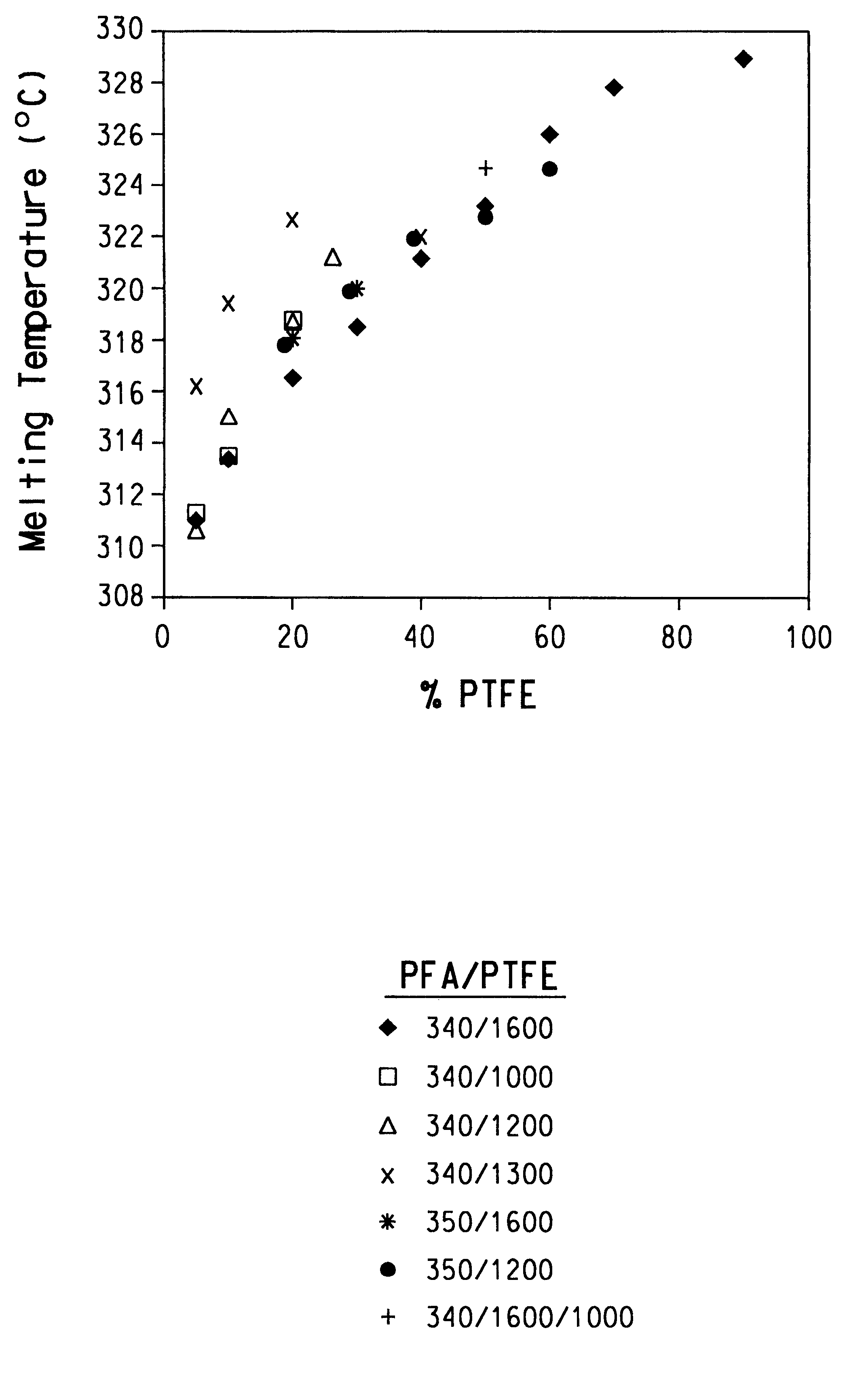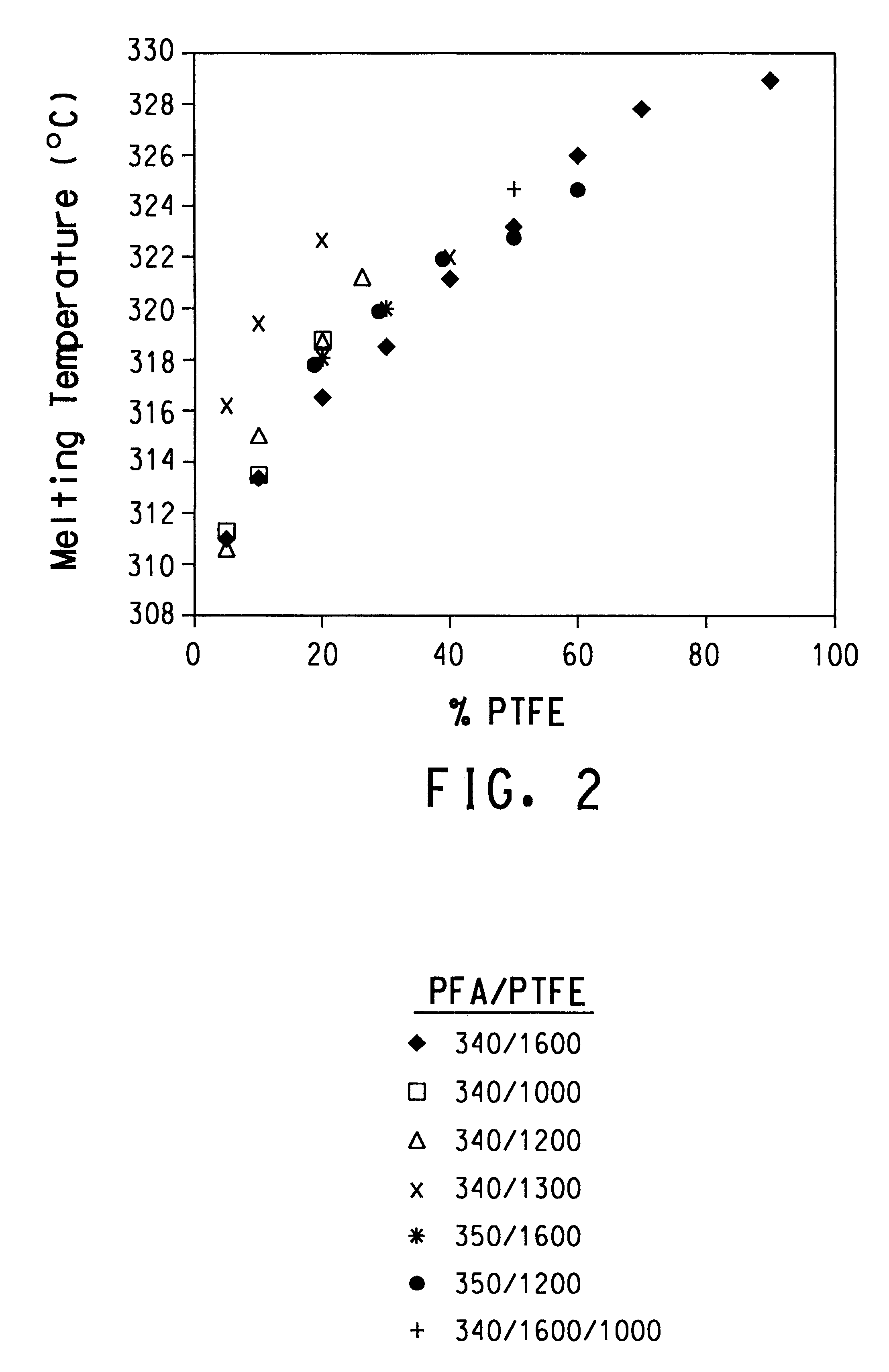Melt spun fibers from blends of poly(tetrafluoroethylene) and poly(tetrafluoroethylene-co-perfluoro-alkylvinyl ether)
a technology of polyethylene and co-perfluoroalkyl ether, which is applied in the field of melt spun fibers of poly (tetrafluoroethylene) and poly (tetrafluoroethylenecoperfluoroalkyl ether) (pfa) to achieve the effect of reducing the number of ptfe grades
- Summary
- Abstract
- Description
- Claims
- Application Information
AI Technical Summary
Problems solved by technology
Method used
Image
Examples
example 1
Blends of Teflon.RTM. PFA 340 with up to 20% of PTFE
Blends of Teflon.RTM. PFA 340 containing up to 20% of four different Zonyl.RTM. PTFE were examined, The melt viscosities of each of the components were determined at 375.degree. C. by capillary rheometry and are shown in FIG. 4. The components in order of their melt viscosity were:
MP1300>MP1000>PFA340>MP1600>MP1200.
All blends were successfully melt-spun, and the maximum spinning speed, V.sub.max, was determined. The effect of the different PTFE grades on spinning speed correlated with their melt viscosity, as shown in FIG. 5. Zonyl.RTM. PTFE having a lower melt viscosity increased V.sub.max of the blend compared to neat PFA 340; those having a higher melt viscosity diminished V.sub.max of the blend.
Fibers of these blends were melt-spun at 75% V.sub.max and collected. The tenacity of these fibers fell in the range of 0.71-1.00 g / den compared to the 0.90 g / den for neat PFA 340. Thus, the addition of up to 20% PTFE did not substantial...
example 2
Blends of Teflon.RTM. PFA 340 with higher PTFE content
Blends of Teflon.RTM. PFA 340 containing from 5 to 90% MP1600 PTFE and pure Teflon.degree. PFA 340 were melt-spun. A plot of maximum spinning speed as a function of PTFE content is shown in FIG. 6. V.sub.max increased with increasing PTFE content up to 80% PTFE. This correlates with the expected decrease in viscosity produced by the addition of the lower viscosity PTFE component. Increasing the PTFE content from 80% to 90% resulted in a sharp decrease in V.sub.max as the spun fiber became increasingly weak and brittle. Neat PTFE MP1600 could not be spun under the conditions employed; the melt would not form a continuous filament as it exited the die. Solidified segments broke easily in a brittle manner, exhibiting virtually zero strength.
The tenacity of fibers spun from PFA 340 / PTFE blends decreased as a function of PTFE content, as shown in FIG. 7. However, even fibers containing up to 80% PTFE demonstrated reasonable tenacities...
example 3
PFA 350 / Zonyl.RTM. MP1200 Blends
Zonyl.RTM. MP1200 PTFE has a melt viscosity at 375.degree. C. that is more than 100 times lower than that of PFA 350, as shown in FIG. 9. This example was performed in order to determine whether the addition of the low-viscosity PTFE could improve the spinnability of PFA 350.
Blends containing 20-90% Zonyl.RTM. MP1200 were melt-spun under a variety of conditions including temperatures of 350-390.degree. C., die diameters of 0.76-3.18 mm, and shear rates of 2-75 / s. The melt viscosity of these blends varied considerably as a function of the blend ratio. Spinning continuity for blends containing 20-70% PTFE MP1200 was established, but in each case draw resonance was observed, which is a flow instability characterized by an oscillation in the fiber diameter. The melt blend containing 90% MP1200 was too weak to be wound up.
PUM
| Property | Measurement | Unit |
|---|---|---|
| break elongation | aaaaa | aaaaa |
| viscosities | aaaaa | aaaaa |
| melt flow rate | aaaaa | aaaaa |
Abstract
Description
Claims
Application Information
 Login to View More
Login to View More - R&D
- Intellectual Property
- Life Sciences
- Materials
- Tech Scout
- Unparalleled Data Quality
- Higher Quality Content
- 60% Fewer Hallucinations
Browse by: Latest US Patents, China's latest patents, Technical Efficacy Thesaurus, Application Domain, Technology Topic, Popular Technical Reports.
© 2025 PatSnap. All rights reserved.Legal|Privacy policy|Modern Slavery Act Transparency Statement|Sitemap|About US| Contact US: help@patsnap.com



